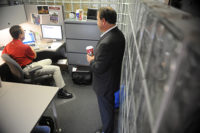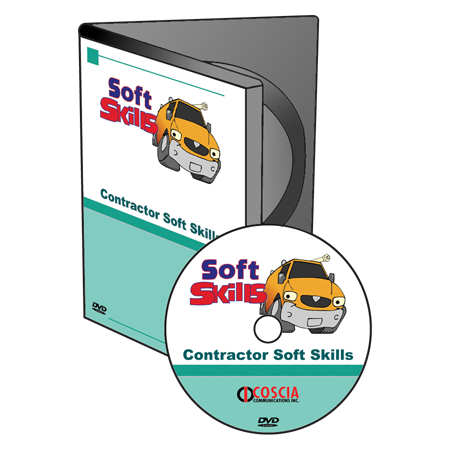Contractor Creates Digital Culture

AirTight
technician Edward Sain prints a PDF version of his service order in his truck.
After printing, he can give it to the customer and explain what he did during
the service call.
With an attitude of looking to the future, AirTight has fostered a digital culture that differentiates it from other contractors. Crumpton said, “Everything we do as a company is home-cooked. We didn’t have some illustrious consultant come in and tell us to do that. This became our culture out of desire and necessity.”
MOBILE TECH FOR TECHS
AirTight has 30 employees, whom Crumpton refers to as “AirTitans.” Since 60 percent of them are in the field, AirTight has invested a lot in mobile technology. Currently, everyone in the field is outfitted with Hewlett Packard (HP) Mini laptops, but this is just the latest in the company’s IT evolution. “We started doing this eight years ago,” Crumpton explained. “We started with Toshiba laptops, which we mounted in the service trucks. And we put a printer in there with a power converter, so you could have a printed PDF document in the truck.”“That was our initiation into using mobile technology,” Crumpton continued, “and we’ve gone through a lot of computers over the years.”
The technicians’ HP Minis are equipped with Verizon Wireless Aircards and run Wintac software by Intac International, which “does all of our dispatching and purchase orders,” Crumpton explained. “When we bought it, nobody had mobile versions of their stuff,” he reminisced. “We paid those guys like 10 grand for a mobile version.” But, he added, it’s been a good partnership, and the Wintac software has provided “everything we need - it’s an affordable, networkable solution.”

Technician
Dennis Osborne uses his laptop to analyze the operating conditions of an HVAC
system in a high-rise building. The company wants each employee to have the
tools they need to do the job well, no matter where they are.
According to Crumpton, he bought an iPad last spring, and while he loves using it, he isn’t ready to buy them for his techs yet. “The screen on the iPad is too dang delicate and right now our guys still break hammers.”
But no matter what computing device his technicians are using, the point is that Crumpton wants them to have the tools they need to do the job well, no matter where they are. As an example, he said, “If you’ve got a technician on the roof of your building and the wiring diagram has been lost, [if he’s got an HP Mini] he’s two clicks away from finding it on Trane.com. So he has the proper tools to do the job - and in this case, it’s not a pair of pliers - it’s an Intel processor.”
AN OPEN APPROACH
When it comes to the company’s overall IT approach, Crumpton said, “We’re in the midst of retooling what we’re doing. We’re looking at the cloud for all of our data rather than keeping it internally on a server.”Currently, the company’s data is still stored in-house, but its e-mail is outsourced. “We’ve started migrating toward thinking about offsite managed service.”
Another novel approach at AirTight is that employees are allowed “full autonomy” to purchase and use the mobile device that works best for them. “Rather than saying ‘We’re going to use this only,’ I like to have them see what works,” Crumpton said.
While the standard company phone is currently the Blackberry Tour, employees can use iPhones or Android phones if they prefer. “Everybody mostly has a Blackberry or iPhone in addition to their computer,” he said. “And we’ve got some Droid users.”

Osborne
and Sain review a printed-out “Digital Controls Alarm Log” from a building
maintained by AirTight after a recent power outage.
THE DIGITAL CULTURE
In his opinion, Crumpton believes the mechanical industry is “horrible at a lot of stuff, including communication and recordkeeping.” Moving to a digital environment, however, can break down barriers to communication and recordkeeping.“When you capture data digitally, as long as you store it properly, it’s always there, making life easier,” Crumpton said. “If you don’t have a way to do that, anytime you have to transcribe from a pen to a phone, there’s room for error. If you capture it one time digitally, as long as proper information goes in on one end, you’ve got good data forever.”
Crumpton is a self-described “obsessive guy,” so he appreciates the precision and efficiency of digital data capture. “I like details and I want to touch things once. And being in the digital world allows you to do that - it makes your company more efficient.” Plus, he said, “We never have to look for stuff - it’s just doing a search on your C drive as opposed to searching through a file cabinet.”
He added that once his technicians record something digitally, they can communicate it quickly and accurately. “The culture of our company is digital right now: Get it digitized, type it once, share it, and get it out there for everybody to use.”

Osborne
and Sain use an HP Mini laptop to record maintenance information. The
contractor uses this data as a way to trend the equipment it services.
Plus, he wants the technicians to be able to communicate professionally with customers. “If you go to most contractor facilities, or if you see their technicians out and about, those guys still handwrite service orders,” he said. “How much more professional is it when our technician prints off a digital PDF and hands it to them? That’s got to set the bar higher.”
Crumpton would love to go completely paper-free, but he said his customers still prefer printed PDFs. “It’s a paperless, not a paper-free system. That’s driven by our customers.” And he always wants to ensure that AirTight’s focus on technology benefits the customer. Crumpton said there has to be a purpose behind technology investments: “At the end of the day, other than cool, what is it doing for our customers and why should they spend their money with us?”
The ultimate goal is to stand out from the crowd. “We really don’t consider ourselves like a regular old air conditioning guy,” Crumpton summed it up. “I think by running a professional company and handling people’s business in a professional way, they can say, ‘We’d rather use AirTight than XYZ Company.’ And that’s because of the uniqueness we bring to the table and part of that uniqueness is our digital culture.”
Publication date: 02/07/2011







